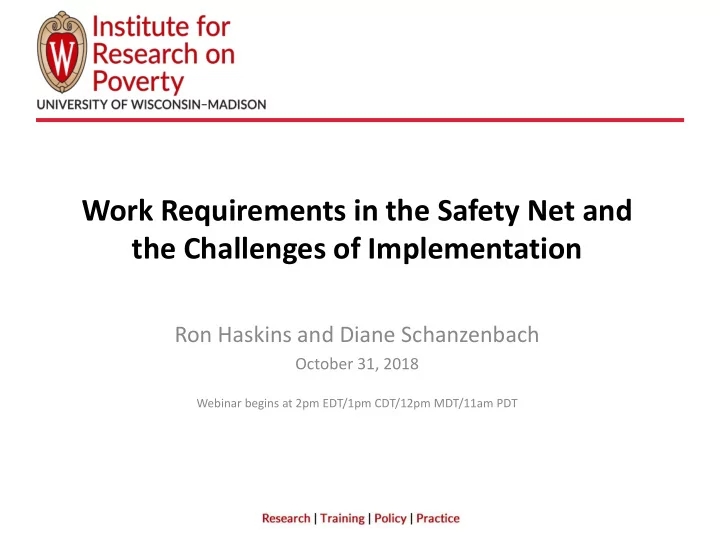

Work Requirements in the Safety Net and the Challenges of Implementation Ron Haskins and Diane Schanzenbach October 31, 2018 Webinar begins at 2pm EDT/1pm CDT/12pm MDT/11am PDT
Ron Haskins Diane Schanzenbach Cabot Family Chair & Co-Director, Center on Director, Institute for Policy Research Children and Families, Margaret Walker Alexander Professor Brookings Institution Northwestern University
Work Requirements in the Safety Net and the Challenges of Implementation October 31, 2018 Ron Haskins Cabot Family Chair & Co-Director, Center on Children and Families Brookings Institution Washington, DC
4 Programs that Support Work • EITC • Child Care • Child Tax Credit & Additional Child Tax Credit • SNAP • Medicaid • TANF • Housing
5
6 Work Requirements in TANF • State work rate of 50% for single-parent families with “work - eligible individuals” (90% for 2 -parent families) • 12 work activities, including: Unsubsidized employment Job search and readiness Work experience Community service Vocational education training • 30 hours per week (20 hours for single parent with child < age 6)
7 Work Requirements in SNAP • Able-bodied adults without dependents (ABAWD) limited to 3 months of benefits in a 36 month period if they do not meet work requirements • Requirements: Work at least 80hrs./month Enrolled in qualifying education or training program 80hrs./month Comply with a workfare program SNAP Education and Training Program
8 Work Requirements in Medicaid • Kentucky, Indiana, Arkansas, and New Hampshire are in the early stages of implementing requirements • Requirements 80 hrs./month Job training Enrolled in education program
9 Work Requirements in Housing • Housing reforms enacted in 1998 contained first work requirements • Requirement; Some recipients of public housing required to participate in community service or self-sufficiency activities for 8 hours each month
10 Big Questions on Work Requirements • Who is subject to work requirements? • What activities count toward work? • How many hours must recipients work to count toward fulfilling the requirement? • What are the sanctions against individuals? • What are the sanctions against states that fail to meet the work requirement? • How is funding handled? Is there money for training? • What kind of evaluation will be conducted and who will pay for it? See Peter Germanis , “Expanding Work Requirements in Non -Cash Welfare Programs: TANF Is Not a Model, but a Cautionary Tale", October 2018.
Work Requirements in the Safety Net & the Challenges of Implementation Diane Schanzenbach Director, Institute for Policy Research Margaret Walker Alexander Professor Northwestern University
“Work Problem” not Limited to those Participating in Safety Net Programs
Spending, Increases Overwhelmingly Going to Earners
Realities of labor market interact with safety net • Low & stagnant wages • Higher unemployment • Less stability in hours • More job displacement • Don’t seem to be “elevators to middle class” https://www.cbpp.org/resear ch/poverty-and- inequality/most-workers-in- low-wage-labor-market-work- substantial-hours-in
Incr creased eased Exp xposu sure re to W Work k Req equir irements ements (SNAP) P) • 22 percent of all participants (4.1 million adults) would be newly exposed under the House bill (purple) • This also has implications for the children and seniors living in these households • A much larger share of adult Medicaid participants (47 percent) could be exposed to proposed work requirements (22 million adults) http://www.hamiltonproject.org/papers/wo rk_requirements_and_safety_net_programs
Labor r marke ket t vo volati tilit lity y (SNAP) P) Younger (18 – 49) newly exposed SNAP participants • 86 percent were in the labor force 46 percent would meet • work requirements consistently, but 28 percent would pass in some months and fail in others Older (50 – 59) newly exposed SNAP participants • Less likely to work (54 percent were in the labor force)
Why hy are re people e not t working: ng: SNAP participant icipants s (age ge 18 – 49) 9) with h depen ependen dents s (age e 6 – 17) Work-related reasons (i.e, labor market volatility) are common reasons for missing work among labor force participants Half of those out of the labor force cite health or disability reasons for not working None cite early retirement and only 0.3 percent report being uninterested in working
Why hy are re pe peopl ple e not t working: ing: SNAP pa parti ticipants ipants (age ge 50 – 59 59) ) wi with th no de depe pende ndents nts unde der r age ge 6 More than half of the older, newly exposed SNAP participants cite health or disability reasons 87 percent of those not in the labor force attribute their lack of work to health or disability Fewer than 3 percent cite retirement or a lack of interest in working
One month snapshots are misleading • Overstates labor force non-participation rates • Understates the share who would not pass work requirement threshold (purple, light green) • Administrative hurdles could penalize even those who are working consistently above the threshold
Responses?
Q & A
Recommend
More recommend